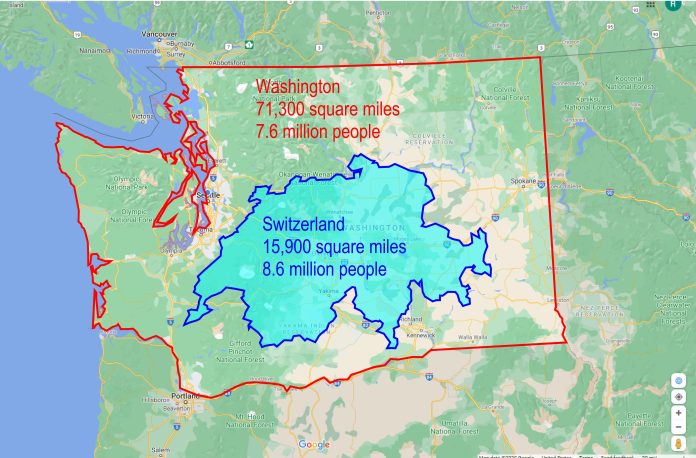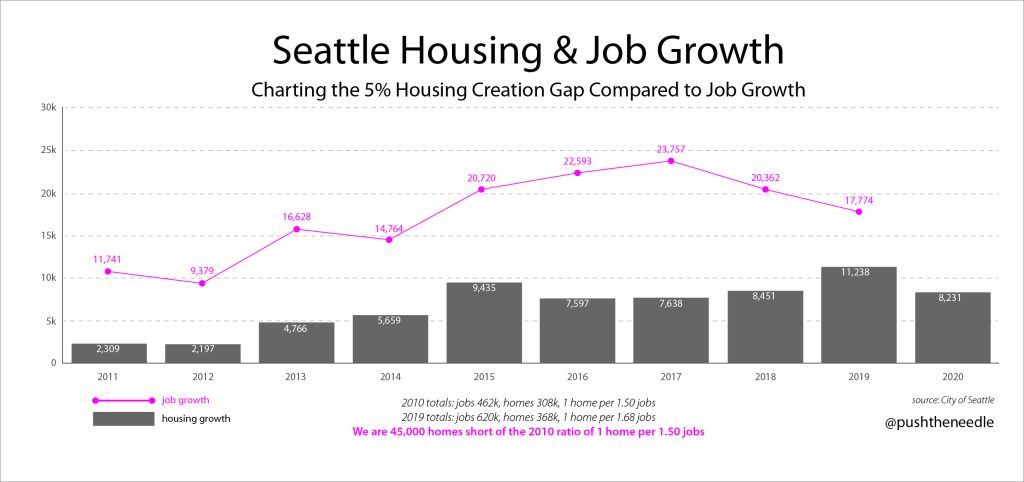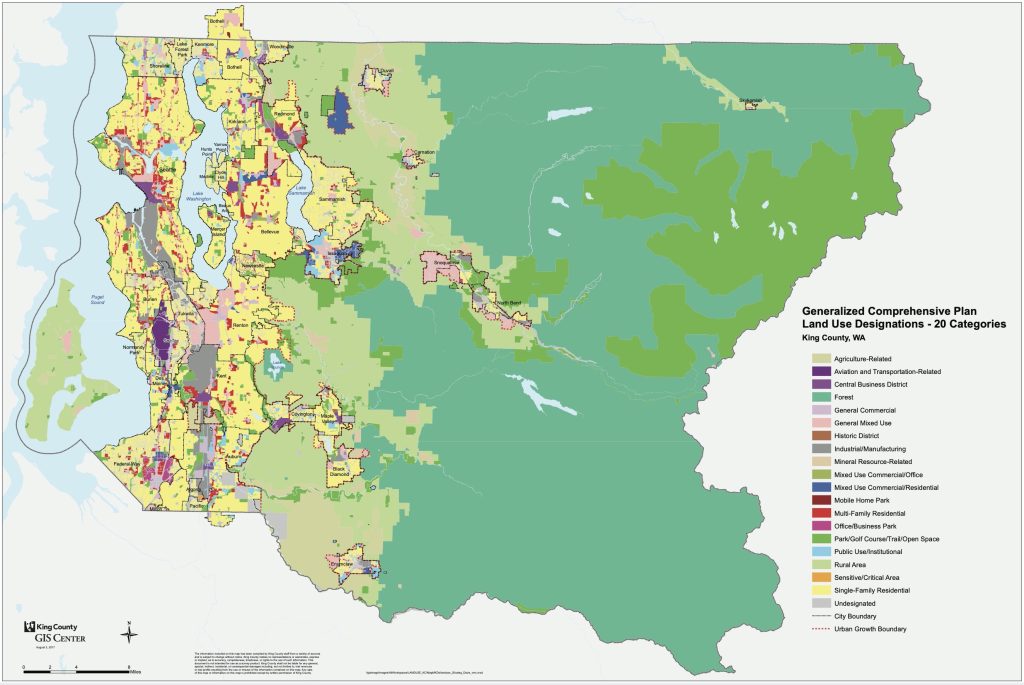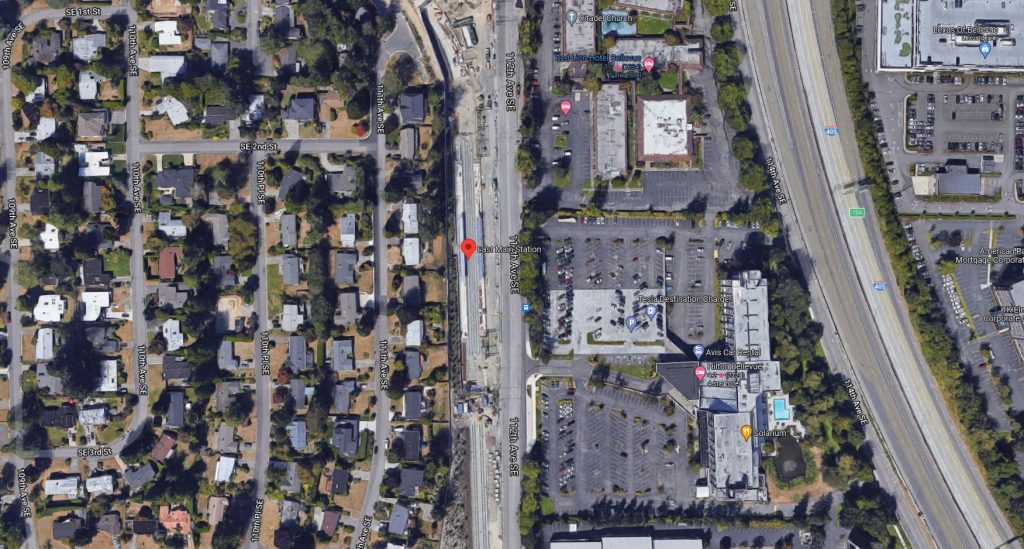
When Bellevue boasted they would eat Seattle’s lunch last month, I am not sure they realized the housing crisis was on the full course menu. For years, Bellevue has successfully lobbied to pull high-priced tech jobs away from Seattle, and now political leaders are caught flat-footed scrambling with a zoning plan to house everyone in response. While Bellevue has successfully grown those jobs, their housing growth has been piddling by comparison. Bellevue’s housing crisis has been a ticking time bomb waiting to explode ever since Amazon’s HQ2 announced those 25,000 jobs across the lake.
It’s no wonder politicians lobby for job growth. Job growth is a good thing. Jobs bring revenue to a city and an opportunity to provide residents the chance to participate in upward mobility — if you maintain space for everyone to live nearby and value equitable guidelines in how you grow. Political leaders work extensively and creatively to lure jobs to their city, some going as far as renaming their towns after the company they were hoping to host. But what always seems to be absent is a concurrent plan for increasing housing. Planning for jobs without homes is like luring the NHL to Seattle only to have them play in a high school arena because the city didn’t bother to build a stadium.
Seattle: the cautionary tale
Seattle’s population growth has been unprecedented. But it’s really the city’s job growth that Bellevue should be monitoring. Seattle’s positive job growth was squandered because the city did not have a housing plan to match it. In 2010, Seattle had 462,000 jobs and 308,000 homes. This was a ratio of 1.50 jobs to homes, a ratio that should have been maintained during this last decade of job growth. People move to cities for jobs and Seattle has had a lot of them. By 2020, jobs reached 620,000 but homes only grew 368,000. While 60,000 new homes sounds great, Seattle remains 45,000 homes short of matching its 2010 jobs to homes ratio. Seattleites have experienced firsthand how when there isn’t enough housing to match job growth, housing costs spike. Wealthier buyers and new renters scoop up housing and push existing residents down another rung, a domino effect that results in even the most affordably priced housing increasing in price, which eventually pushes people into homelessness.

But as bad as the situation appears in Seattle, Bellevue is in far worse shape. With 150,000 jobs today, and only about 63,000 homes, the city is already 38,000 homes short of the 1.50 ratio. Not tomorrow, today. This is before Facebook opens their new offices in the Spring District and before Amazon fills the two million square feet of office space currently under construction. There are another 30,000 jobs on the horizon, meaning Bellevue needs to double its current housing stock before those jobs show up. With low vacancies and far less missing middle or apartment housing available, the problems of soaring costs — and increased homelessness — will be exacerbated. Seattle dedicates 75% of residential land to single family zoning — even if two additional dwelling units (ADUs) are now allowed. In Bellevue, the amount land dedicated to single family zoning is similarly aroud 75%, but with larger lot minimums and no ADU allowance. Thus, without substantial zoning changes, Bellevue will have nowhere to grow as new jobs move in.
The housing crisis has hit the whole metro area
These problems related to the housing crisis are not unique to Seattle, Bellevue, or even Tacoma. Other parts of the metro area have struggled with soaring housing costs as cities and suburbs are tapped out. King County currently dedicates 75% of residential land to single family zoning. This means 293 square miles of the county — which composes the bulk of the Seattle metro area — cannot significantly increase housing due to its zoning. The region has only set aside 97 square miles to build anything from a townhouse to a highrise.
The Growth Management Act (GMA) prevents sprawl and establishes boundaries for where housing can be built, which means cities obviously cannot retain stagnant residential zoning while jobs continue to be added. King County’s 390 square miles of buildable area for housing is larger than all of New York City — a city that houses over 8 million people. For comparison, Washington State’s entire population is 7.7 million residents.

The investment in Link light rail provides opportunities for other areas to participate in sustainable housing growth. But where can these cities and suburbs grow? Like Seattle and Bellevue, far too much of Shoreline, Lynnwood, Redmond, Kirkland, Bellevue, Renton, Kent, Tacoma, Federal Way, SeaTac, Burien, and Bothell are zoned for single family homes. And nearly all those areas have already been built out.
Across the Seattle metro region, we have seen an unwillingness to fully embrace transit-oriented planning. In Shoreline, parking garages are being built, while in Seattle, neighborhood group’s complaints have cut towers down to mid-rises. Bellevue’s East Main Station has an oversized parking lot on one side, and a suburban housing development on the other. Our region is building commuter rail for car dependency, failing to capitalize on a crucial investment. Worst of all, the Link light rail line predominantly follows urban highways, sacrificing acres of land that could be used for housing and creating a hostile barrier that squeezes down the walkshed of where people can safely and comfortably live car-free.

The housing crisis has reached Tacoma, Snoqualmie, Snohomish, and every other far-reaching area imaginable because the region has the jobs, but it doesn’t have the homes. Our metro area isn’t building density around our transit stations as are being built in suburban Vancouver, we aren’t upzoning our cities to allow something as basic as a sixplex citywide, and we are not going unbind our growth boundaries and deforest more land so we can plop in track homes and exacerbated the car dependency that got us into this climate crisis in the first place.
This is a statewide issue
Zooming out, this is not just a Seattle metro area problem or a King County problem. Washington State is 475,000 homes short of the 2010 ratio of jobs to homes. Therefore, Spokane is now part of the Seattle metro’s housing crisis, with work-from-home flexibility growing in the region and priced out remote workers looking for more reasonably priced places to live.
It’s time for Washington State to come up with a plan. This state is four-times larger than Switzerland, a country that has a million more people than we do. Switzerland has similar terrain as Washington State, but the country still somehow houses a million more residents despite having one-quarter of our land. Swiss cities are compact and the three largest cities (Zurich, Geneva, and Basel) could all fit within the footprint of Spokane with 20 square miles to spare.

Single family zoning is holding Washington State back, and it is crystal clear that no city has the will to take on zoning reform. Seattle upzoned 6% of single family zones and sat in an expensive appeals process after a rigorous multi-year community outreach effort. Even renaming single family zoning as “neighborhood residential” required time and effort. Tacoma presented a bold plan to reform single family zoning only to have it watered down by locals who don’t want to share their neighborhoods. Bellevue is scrambling to hire enough planners to handle the amount of work necessary to meet its goals for the arrival of East Link light rail in 2024. And while Bellevue is in the process of trying to reform and rezone areas for growth, I cannot imagine what community process those planners will have to sit through.
So as the jobs keep coming, our political leaders at every level must ask themselves, where will these people go? Well, I have an answer, they can join us right here in the urban areas where we all live already. By allowing a sixplex on any lot in Seattle we have the capacity to be a city of two million. By reducing lot minimums in the suburbs, allowing rowhouses and quadplexes, this whole metro area could double its population. These changes are minimal and only need political will. Job growth is popular, but a plan for increasing housing is not. Maybe the best thing to do politically is accept these changes at the state level and mimic what our neighbors are doing in California and Oregon’s legislatures, which passing sweeping zoning reform that requires a housing growth plan at the municipal level. Either way, cities have to get the ball rolling, or else former Governor Christine Gregoire and other advocates for building new cities on undeveloped land will continue their search for the next Cascadian forest to cut down.

Ryan DiRaimo
Ryan DiRaimo is a resident of the Aurora Licton-Springs Urban Village and Northwest Design Review Board member. He works in architecture and seeks to leave a positive urban impact on Seattle and the surrounding metro. He advocates for more housing, safer streets, and mass transit infrastructure and hopes to see a city someday that is less reliant on the car.
